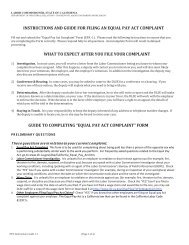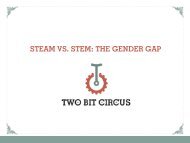EQUITY
2eGXKK2
2eGXKK2
You also want an ePaper? Increase the reach of your titles
YUMPU automatically turns print PDFs into web optimized ePapers that Google loves.
Yet, in many ways, employers, policy makers,<br />
and workforce developers concerned with<br />
addressing skill shortages and improving<br />
women’s economic security are confronted<br />
with a ‘chicken & egg’ problem that goes<br />
beyond the similarity or differences between<br />
individual occupations. The scarcity of<br />
women in the target occupations can make<br />
Employers are losing out on half of the workforce,<br />
and on the half that has the higher and more rapidly<br />
rising educational attainment<br />
specific ways firms across different<br />
sectors can create more gender-inclusive<br />
environments that successfully retain female<br />
talent (Deloitte Development LLC and The<br />
Manufacturing Institute, 2012). These include<br />
targeted leadership, training, mentoring,<br />
and sponsorship programs for employees<br />
at all levels, flexible workplace policies, and<br />
a “results-driven” culture that discourages<br />
the notion that an employee must work<br />
the longest hours to be deemed successful.<br />
Steps include:<br />
women feel isolated, may expose them to<br />
harassment and discrimination, and, in<br />
jobs where skills acquisition depends on<br />
the training provided by senior co-workers,<br />
may make it hard for them to become<br />
fully-skilled. Having few women moreover<br />
makes these occupations less innovative<br />
in the way work is organized to respond to<br />
workers’ dual responsibilities, for paid work<br />
and for unpaid family work for children, or<br />
elderly parents or spouses who may need<br />
supports. When work is still organized as if<br />
workers had no responsibilities outside of<br />
the workplace, women don’t join, or join and<br />
leave the occupation, while the occupation<br />
recreates an isolating environment that<br />
pushes women out and hinders the<br />
occupation from ever evolving. Yet, given<br />
current and projected skill shortages, past<br />
attitudes of complacency may finally<br />
become too expensive and barriers to<br />
women may come down. Many employers<br />
have already adopted more inclusive and<br />
flexible working arrangements and provide<br />
examples of what can be done.<br />
For Employers<br />
A 2012 report by Deloitte and The<br />
Manufacturing Institute highlights the<br />
■■<br />
■■<br />
■■<br />
■■<br />
■■<br />
■■<br />
■■<br />
Reviewing recruitment and outreach<br />
materials to ensure the use of inclusive<br />
language and images<br />
Ensuring that the channels for<br />
advertising vacancies and opportunities<br />
reach women as well as men<br />
Reviewing recruitment and selection<br />
processes to ensure that they are free of<br />
gender bias and affirmatively encourage<br />
female talent<br />
Ensuring that women, just as men, have<br />
adequate facilities, including protective<br />
gear that is appropriate to different<br />
body types and facilities that are<br />
sanitary and safe<br />
Actively encouraging an inclusive<br />
environment and clearly communicate<br />
that hostile behaviors, such as<br />
harassment and discrimination, are not<br />
acceptable.<br />
Communicating that women as well as<br />
men are expected to advance and thrive<br />
in the company<br />
Being deliberate: setting targets and<br />
measuring their company’s progress to<br />
greater gender inclusiveness.<br />
34 NARROWING THE WAGE GAP BY IMPROVING WOMEN’S ACCESS TO GOOD MIDDLE-SKILL JOBS




